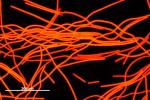A beneficial effect of a toxic cyanobacterium on aquatic bacteria
Blooms of cyanobacteria producing toxic compounds usually negatively affect aquatic organisms including bacteria. However, our study revealed a beneficial effect of the filamentous photoheterotrophic cyanobacterium Planktothrix rubescens (see attached picture, ©T. Posch) on bacteria from the genus Limnohabitans, representing one of the key groups of freshwater bacteria. P. rubescens forms dense and persistent populations in the metalimnion of lakes and is well adapted to the low quantities of light. Contrary, very few filaments are present in the surface and deep layers of the water column during periods of stable stratification. The heterotrophic activity of P. rubescens has been analyzed and quantified using a newly developed approach. The availability of light has been identified the key factor affecting the activity of P. rubescens and its relationship with accompanying bacteria. Exposure of cyanobacteria to increased irradiance or to darkness resulted in a significant decrease of their activity, the degradation of photosynthetic pigments and the fragmentation of the filaments in comparison to optimal light conditions. In contrast, growth and metabolic activity of bacteria from the genus Limnohabitans significantly increased in the presence of physiologically stressed cyanobacteria both in mixed assemblages and in pure co-culture. Thus, under specific conditions toxic cyanobacteria may have an overall positive effect on some aquatic microbes.
The study was partly supported by the Czech Science Foundation (project GAP504/10/1534) and resulted from cooperation between Institute of Hydrobiology, Biology Centre AS CR, České Budějovice (Czech Republic) and Limnological station, Institute of Plant Biology, Kilchberg (Switzerland).
- Horňák K., Zeder M., Blom J.F., Posch T., Pernthaler J. (2012) Suboptimal light conditions negatively affect the heterotrophy of Planktothrix rubescens but are beneficial for accompanying Limnohabitans spp. Environmental Microbiology 14(3): 765-778. [IF = 5.537]
http://onlinelibrary.wiley.com/doi/10.1111/j.1462-2920.2011.02635.x/abstract















